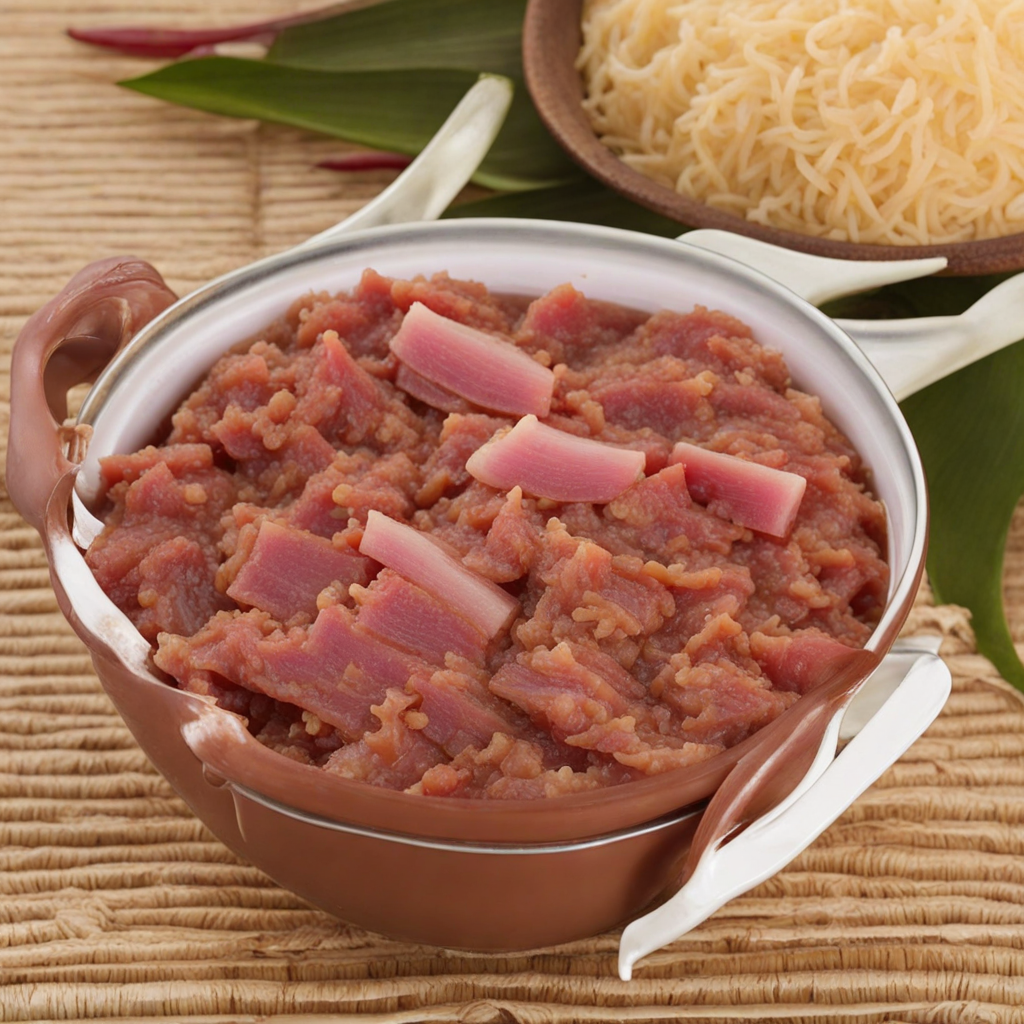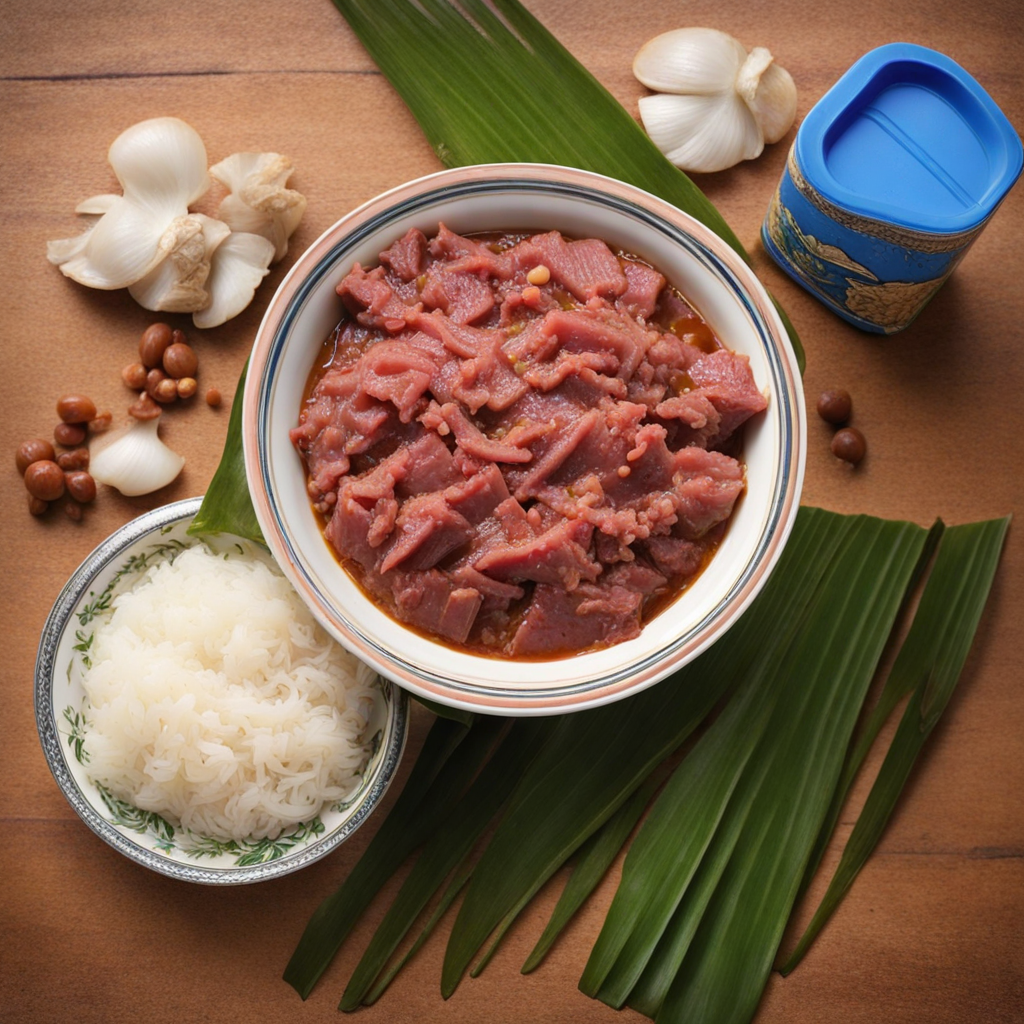Pisupo
Pisupo is a traditional Samoan dish that showcases the rich culinary heritage of the islands. Essentially, Pisupo is canned corned beef, a food that has become a staple in many Pacific Island communities. The dish is often prepared with a blend of local ingredients, creating a unique fusion of flavors. When cooked, the corned beef takes on a tender texture, infused with savory spices that reflect the island's tropical climate. It is frequently served alongside rice, taro, or boiled root vegetables, making it a hearty and satisfying meal. The preparation of Pisupo can vary, but it often includes sautéing the corned beef with onions, garlic, and a medley of colorful vegetables, such as bell peppers and carrots. This not only enhances the flavor but also adds vibrant visual appeal to the dish. The combination of the salty meat with the sweetness of the vegetables creates a delightful balance that tantalizes the palate. Many Samoan families have their own cherished recipes that may include additional spices or even a touch of heat from chili peppers. Pisupo is more than just food; it embodies the spirit of community and sharing in Samoan culture. It is commonly enjoyed during family gatherings and special occasions, often accompanied by laughter and storytelling. The dish has also evolved with time, finding its way into modern cuisine while still holding onto its traditional roots. For those seeking to explore new tastes, Pisupo offers a delicious glimpse into the heart of Samoan cooking, providing an experience that is both comforting and exciting.
How It Became This Dish
Pisupo: A Culinary Journey Through Samoan Culture Origins of Pisupo Pisupo, a traditional Samoan dish, has roots that intertwine with the broader history of Pacific Islander cuisine. The word "pisupo" translates to "pea soup" in Samoan, but its significance extends far beyond mere ingredients. Historically, pisupo refers to a dish made from split peas or yellow peas, often cooked slowly with pork, onions, and various seasonings. The practice of preparing pisupo has evolved significantly over the years, reflecting the island's changing relationships with food, culture, and globalization. The origins of pisupo can be traced back to the early Polynesian settlers who arrived in Samoa between 3,000 and 2,500 years ago. These early inhabitants brought with them a wealth of agricultural knowledge, cultivating crops that would become staples of Samoan cuisine, such as taro, yams, and coconuts. The introduction of European contact in the late 18th century marked a significant turning point in Samoan culinary practices. With the arrival of traders and missionaries, new ingredients, cooking methods, and recipes began to seep into the local food culture. Cultural Significance of Pisupo Pisupo holds a special place in Samoan culture, often associated with communal gatherings, celebrations, and traditional feasts known as "fa'alavelave." The dish symbolizes hospitality and togetherness, as families and communities come together to share a meal. During significant events such as weddings, funerals, and cultural festivals, pisupo is often prepared in large quantities and served as a central dish, embodying the spirit of generosity that is deeply rooted in Samoan customs. Moreover, pisupo is more than just a food item; it represents the resilience of Samoan identity. During times of hardship, particularly during World War II and the subsequent economic struggles, pisupo became a practical dish that could be made with limited resources. The use of split peas allowed families to create a nutritious meal while maximizing the use of local ingredients. This adaptability reflects the broader Samoan ethos of sustainability and resourcefulness, qualities that have been passed down through generations. The Development of Pisupo Over Time As Samoa transitioned through various historical phases, the preparation and perception of pisupo evolved. In the early 20th century, the introduction of canned goods and processed foods began to change the landscape of Samoan cuisine. One notable development was the emergence of canned corned beef, which became a staple in many Pacific Island diets, including Samoa. This imported ingredient was often incorporated into traditional dishes, including pisupo, leading to a fusion of flavors and textures. The combination of split peas and corned beef in pisupo became particularly popular in the mid-20th century, especially during the post-war period. Canned corned beef, typically produced in New Zealand or the United States, was affordable, accessible, and had a long shelf life. This convenience allowed families to prepare pisupo quickly, adapting the dish to modern lifestyles while still maintaining its communal essence. As a result, pisupo became not only a comfort food but also a symbol of adaptability in the face of changing times. The 1980s and 1990s saw a resurgence of interest in traditional Samoan foods, spurred by a growing emphasis on cultural identity and pride among the Samoan diaspora. As Samoans migrated to countries like New Zealand, Australia, and the United States, they carried their culinary traditions with them. In these new environments, pisupo began to evolve further, incorporating local ingredients and flavors while retaining its foundational elements. This phenomenon highlights the fluidity of food and culture, demonstrating how dishes can adapt and thrive in diverse settings. Pisupo in Modern Times Today, pisupo continues to be a beloved dish in Samoa and among Samoan communities worldwide. While traditional recipes remain popular, contemporary cooks have embraced innovation, experimenting with new ingredients and cooking methods. The resurgence of interest in organic and locally sourced foods has also influenced the preparation of pisupo, encouraging a return to using fresh, locally grown peas and traditional meats. In recent years, the global food movement has brought attention to the importance of indigenous foods and traditional cooking techniques. As a result, pisupo has been celebrated not only as a delicious dish but also as a cultural artifact that tells the story of the Samoan people. Cooking classes, cultural festivals, and community events often feature pisupo, allowing younger generations to connect with their heritage while sharing their culinary skills with others. Moreover, the rise of social media has facilitated the sharing of pisupo recipes and stories among Samoan communities worldwide. Home cooks and chefs alike showcase their interpretations of pisupo on platforms like Instagram and TikTok, sparking conversations about identity, tradition, and the evolving nature of culinary practices. This digital age has allowed for the preservation of cultural heritage while simultaneously embracing innovation, ensuring that dishes like pisupo remain relevant in a rapidly changing world. Conclusion Pisupo is more than just a dish; it is a testament to the rich history, resilience, and adaptability of Samoan culture. From its origins among early Polynesian settlers to its evolution amidst globalization and culinary innovation, pisupo embodies the spirit of community, hospitality, and cultural pride. As Samoan communities continue to navigate the complexities of modern life, pisupo remains a cherished symbol of their heritage, a bridge between the past and the present, and a delicious reminder of the power of food to bring people together.
You may like
Discover local flavors from Samoa







